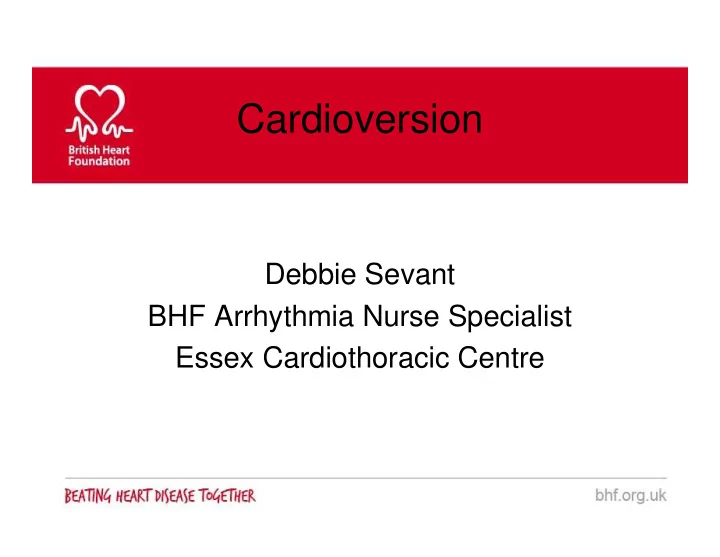

Cardioversion Debbie Sevant BHF Arrhythmia Nurse Specialist Essex Cardiothoracic Centre
Cardioversion • Safe and effective treatment to restore the heart to a normal rhythm • Common treatment for Atrial Fibrillation • Other rhythms may be cardioverted • Treatment protocols vary
Case Study • A 45 year old lady with a history of diabetes presented to her GP with shortness of breath and fatigue. • Examination revealed an irregular pulse. • ECG revealed Fast Atrial Fibrillation, heart rate 140 bpm.
Why do I need Cardioversion ? • Normal Conduction • AF - chaotic electrical activity • Causes fibrillation of atria of the heart • Loss of atrial kick / contraction • Can cause Symptoms & Complications
Symptoms • Asymptomatic • Mild to severe • GP, clinic, urgent treatment • SOB • Fatigue • Dizziness • Syncope • Chest pain
Complications of AF • Risk of blood clots • 5 fold increased risk of stroke • Aspirin Warfarin • Risk stratification CHAD, NICE
Initial Treatment of AF • Control Heart Rate < 80bpm at rest – Beta Blockers – Calcium Antagonists – Digoxin – Emergency - Cardioversion
Initial Treatment of AF • Reduce risk of Blood Clots – Aspirin – Warfarin
Who is suitable for Cardioversion? • Heart Rate Control • Cardioversion • Patients over 65 • Presenting for the first time with lone AF • Patients with coronary heart disease • Younger patients • Patients unsuitable for cardioversion • Patients with Symptoms • Patients who can’t take antiarrhythmic drugs • Patients with AF secondary to another cause eg. Thyroid abnormality, post surgery • No Symptoms
History of Cardioversion • 1775 Abildgaard showed that hens could be made lifeless with electrical impulses and he could restore a pulse with electrical shocks across the chest.
First Cardioversion • 1947 Claude Beck pioneering cardiovascular surgeon in Cleveland, successfully defibrillates a human heart during cardiac surgery. The patient was a 14 year old boy His prototype defibrillator followed experiments on defibrillation in animals performed by Carl J. Wiggers,
Chemical Cardioversion • Cardioversion can be “chemical” or “electrical” • Chemicals alter the heart’s electrical properties to suppress the abnormal heart rhythms and restore a normal rhythm • In- Patient • Out-Patient • Common – Amiodarone, Sotalol, Flecainide
Direct Current Cardioversion • Electrical cardioversion - a synchronized electrical current (shock) is delivered through the chest wall to the heart through special electrodes or paddles that are applied to the skin of the chest and back • Interrupt the abnormal electrical circuit(s) in the heart and to restore a normal heart beat
Procedure • Hospital Setting Day case • Nurse, Anaesthetist, ODA, “Cardiologist” • Warfarin levels prevent stroke • TOE • GA or Sedation • Fast 6 hours • Take all medication that day except diabetic
Paddle Position
Result • Synchronised • Amount of Joules • Success 99.4% locally – biphasic technology
Recovery • Minor skin burn – common • Arrhythmia - bradycardia • Clot Event 1 in 100 • Anaesthetic Effect • Do NOT drive 24 hours • No important decisions 24 hours • Accompanied home • Pacemaker Check
How effective is it ? • 50% recurrence within a year • Increased risk of recurrence with repeat procedures • Follow Up – Often none – NICE : 1 month & 6 months – RAAF Experience – Consider Ablation
Case Study • A 45 year old lady with a history of diabetes presented to her GP with shortness of breath and fatigue. • Examination revealed an irregular pulse. • ECG revealed Fast Atrial Fibrillation, heart rate 140 bpm. • Atenolol 25mg od was commenced to reduce her heart rate.
Case Study • A referral was made to the local Rapid Access AF Clinic and Warfarin was commenced • The Patient was seen in the Rapid Access AF Clinic 2 weeks after referral • Echocardiogram at that clinic showed a normal heart • Admission for DC Cardioversion was arranged once INR was within range • Referral to Treatment 12 weeks
Case Study • This lady successfully cardioverted to normal rhythm with one 200 joule shock • She was seen 3 months after DC cardioversion in the AF follow up clinic • ECG showed normal rhythm and warfarin was stopped
Recommend
More recommend